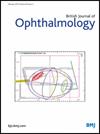Enhancing diabetic retinopathy diagnosis and grading: a retrospective study on AI-assisted decision making and cost analysis.
IF 3.5
2区 医学
Q1 OPHTHALMOLOGY
引用次数: 0
Abstract
BACKGROUND/AIMS Diabetic retinopathy (DR) is a major ocular complication of diabetes mellitus. While artificial intelligence (AI)-based DR screening tools have gained widespread adoption, most research focuses on comparing AI performance with human, with limited attention to AI's role as assistants. This study evaluates the impact of AI-assisted decision-making on DR diagnosis and grading based on colour fundus photographs (CFP) and ultra-widefield fundus (UWF) images. METHODS A total of 224 retinal images were analysed by 21 ophthalmologists and primary care physicians (PCPs) in China. Participants independently diagnosed and graded DR based on CFP and UWF images. After a 1-week interval, they repeated the task with AI assistance. Diagnosis accuracy was compared with a gold standard before and after AI assistance. Incremental costs and accuracy improvements were assessed using generalized estimating equations (GEE) models. RESULTS AI assistance significantly improved DR diagnosis accuracy for both CFP and UWF images. For CFP, accuracy increased from 79.90% to 85.68% for PCPs, 81.19% to 88.69% for ophthalmic residents and 81.41% to 88.05% for ophthalmic attendings. Similar improvements were observed for UWF, with accuracy rising from 83.62% to 89.66% for residents and from 81.31% to 88.98% for attendings. GEE analysis revealed an incremental cost of 4.79 units and an accuracy improvement of 0.35 units with AI assistance. CONCLUSION AI assistance shows potential in improving the accuracy of DR diagnosis and grading. Despite the associated costs, AI enables ophthalmologists to achieve superior diagnosis, facilitating earlier DR detection and treatment.加强糖尿病视网膜病变的诊断和分级:人工智能辅助决策和成本分析的回顾性研究。
背景/目的:糖尿病视网膜病变(DR)是糖尿病的主要眼部并发症。虽然基于人工智能(AI)的DR筛选工具已经被广泛采用,但大多数研究都集中在将人工智能的表现与人类进行比较,而很少关注人工智能作为助手的作用。本研究评估了基于彩色眼底照片(CFP)和超广角眼底(UWF)图像的人工智能辅助决策对DR诊断和分级的影响。方法对全国21名眼科医生和初级保健医生(pcp)的224张视网膜图像进行分析。参与者根据CFP和UWF图像独立诊断和分级DR。间隔一周后,他们在人工智能的帮助下重复这个任务。将人工智能辅助前后的诊断准确性作为金标准进行比较。使用广义估计方程(GEE)模型评估增量成本和精度改进。结果辅助诊断可显著提高CFP和UWF影像的诊断准确率。对于CFP, pcp的准确率从79.90%提高到85.68%,眼科住院医师的准确率从81.19%提高到88.69%,眼科主治医师的准确率从81.41%提高到88.05%。UWF也有类似的改善,住院医生的准确率从83.62%上升到89.66%,主治医生的准确率从81.31%上升到88.98%。GEE分析显示,人工智能辅助下的增量成本为4.79个单位,准确性提高了0.35个单位。结论人工智能辅助在提高DR诊断和分级准确性方面具有一定的潜力。尽管有相关的成本,但人工智能使眼科医生能够实现卓越的诊断,促进早期DR的发现和治疗。
本文章由计算机程序翻译,如有差异,请以英文原文为准。
求助全文
约1分钟内获得全文
求助全文
来源期刊
CiteScore
10.30
自引率
2.40%
发文量
213
审稿时长
3-6 weeks
期刊介绍:
The British Journal of Ophthalmology (BJO) is an international peer-reviewed journal for ophthalmologists and visual science specialists. BJO publishes clinical investigations, clinical observations, and clinically relevant laboratory investigations related to ophthalmology. It also provides major reviews and also publishes manuscripts covering regional issues in a global context.

 求助内容:
求助内容: 应助结果提醒方式:
应助结果提醒方式:


